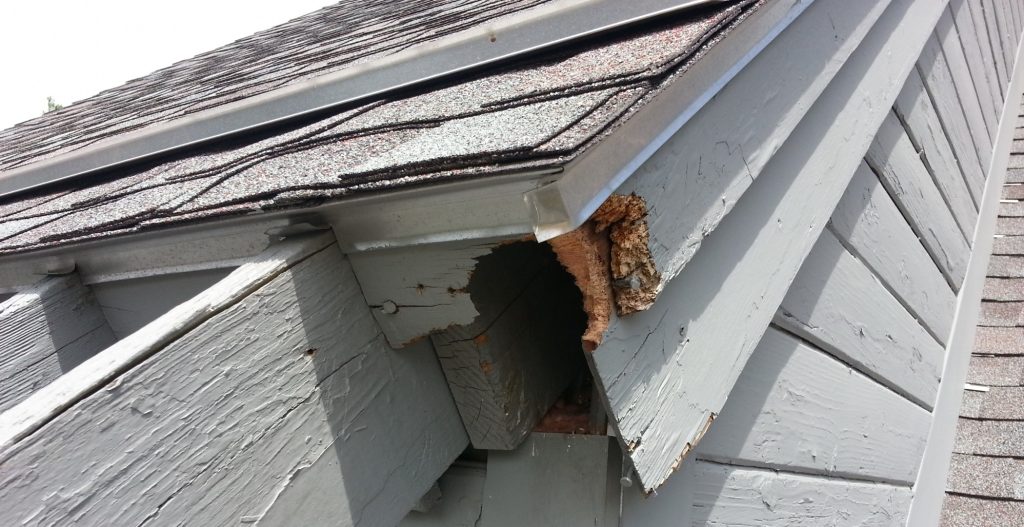
Squirrels might be adorable when scampering about the yard, but they quickly lose their charm when living within a home’s walls or attic. Squirrels are energetic and nimble creatures that excel at climbing and leaping.
And like most nuisance pests, they’ve become accustomed to living amongst people because as urban and suburban areas grow, their habitats shrink. So when they need a warm, secure place to nest for the winter and raise their young, homes become a common choice of residence.
Many people are unaware that squirrels are rodents. The four teeth at the front of their mouths continue to grow throughout their lives, so their teeth don’t get worn out from chewing on the hard shells of the nuts and acorns they eat. These same teeth make it possible for them to gnaw through almost any material a house is constructed from. While much cuter than rats, the damage they cause is significant.
How Do Squirrels Get Into an Attic?
As squirrels spend their days running up and down trees and jumping from branch to branch, they have a bird’s-eye view of home roofs and their weaknesses. Squirrels can jump four feet vertically and jump six to eight feet horizontally.
Because squirrels do not hibernate in winter, the warmth they feel coming from gaps makes an ideal winter den. Squirrels will use their teeth to gnaw through damaged or unscreened vents or tiny gaps to enter the attic. And they most often use the branches of trees near the home or wires to get to the roof. While ideal for squirrels, their presence damages homes and poses health risks for the families within.
Squirrels only need a gap of 1.5 inches to gain entry. The most common places where squirrels find entry into your attic include:
- Soffits – These are the finishing material, mostly made of wood or fiber cement, that covers the underside of a roof overhang. In addition to helping to make the roofline look aesthetically nice, soffits help keep moisture away from the rafters, reducing the chance of mold. Soffits that are not flush with the siding create a gap for squirrels to enter.
- Fascia Boards – These are thin longboards that run along the lower outer edge of a roof, covering the entire roofline. They help keep water out.
- Ridge Vents – Ridge vents are air exhaust vents installed on the peak of a roof that provides continuous exhaust ventilation at the highest part of the attic. Squirrels are attracted to the warm air that comes out of these vents.
- Gable Vents – On a gabled roof, these vents are located at the peak where the two sides meet. They usually have louvers, allowing air to flow into the attic, which works to cool it down in warm weather.
- Roof Returns – This is the part of the roof that doubles back to the wall of the house. It is between the end of the roof and a home’s walls.
- Chimneys – Chimneys conduct smoke and combustion gasses up from a fireplace, stove, or furnace and can run through the attic of a house.
- Siding Corners – This is the trim used to keep your siding in place where the corners meet.
- Gutters – Gutters capture rainwater and melting snow and channel it away from the house. Clogged gutters that prevent precipitation from running will cause deterioration along the roof edge through which a squirrel can enter.
- Plumbing Mats – This is rubber matting covering cylindrical vents on the roof that connect the plumbing system used to exhaust gasses.
| Squirrel Entry Points | Squirrel Exclusions |
|---|---|
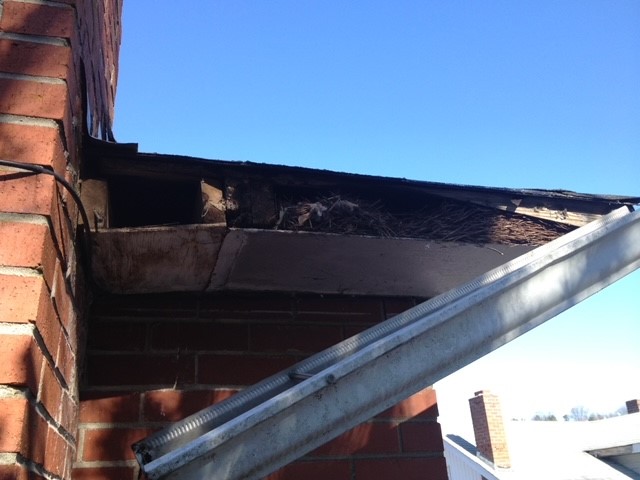 | 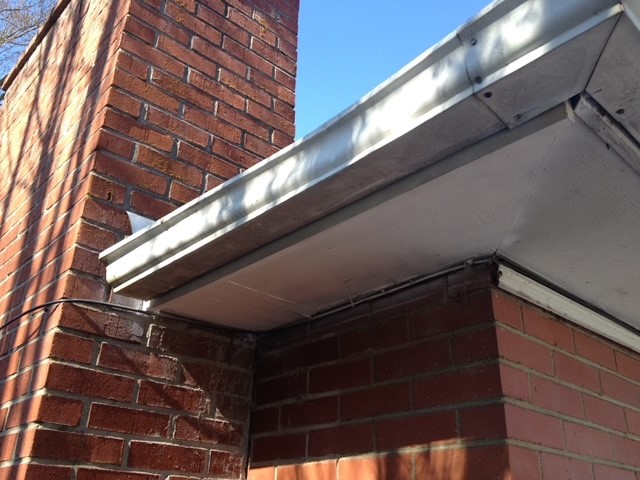 |
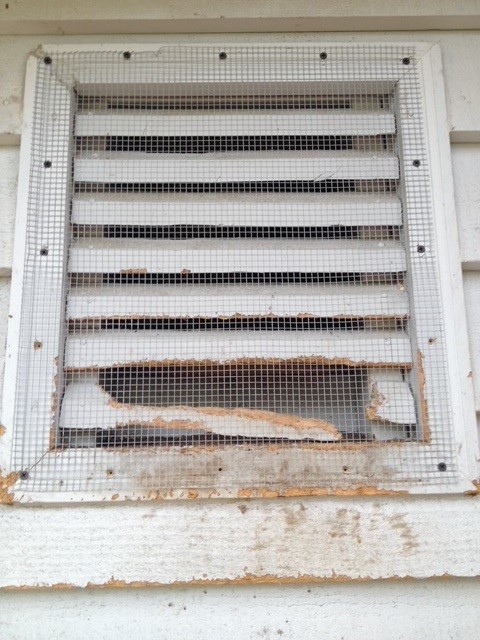 | 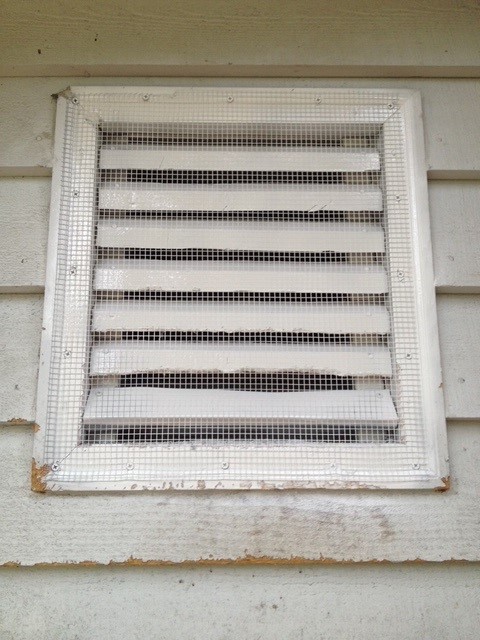 |
Before and after squirrel damage photos courtesy of Critter Control in Atlanta.
Wall and Crawl Space Squirrel Nests
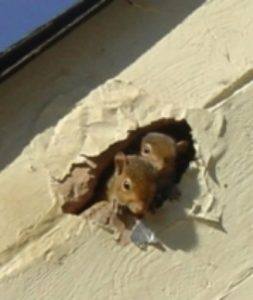
While attics are the most common areas of a home where squirrels can be found, property owners should be aware that squirrels also enter homes through wall vents and crawlspaces.
- Wall Vents – These are vents on the side of a home for kitchen, bathroom, and dryer fans. Because they look like a tree cavity, squirrels find them perfect places to build a nest.
- Crawlspaces – A crawlspace is an unfinished space between the ground and the first floor that is not tall enough to stand in. It provides access to plumbing, wiring, and other household systems without the need for excavation. Not every home has a crawlspace.
Squirrel Control and Exclusion
The best way to prevent squirrels from entering a home is property maintenance. Go into your attic during the daytime and see if there are areas where you can see out. Seal all of those gaps. Cap or place mesh on chimneys and vents. Trim the tree branches that make it easy for squirrels to hop right onto your roof.
If a squirrel does set up residence, call a wildlife specialist to humanely show them the exit. Squirrels can become aggressive when approached, especially if there are kits. And they carry parasites and diseases as well. Professionals are the quickest and most efficient solution to a pesky squirrel in the attic.
Get them out.
Keep them out.®
Experiencing a wildlife or pest issue? We can help! Complete this form and your local Critter Control® office will contact you to assist.
- How to Get Rid of Squirrels
- Squirrels in Attics
- Squirrels in Chimneys
- Squirrels on Roofs & in Soffits
- Squirrels in Walls
- Squirrels in Ventilation
- Squirrels in Gutters
- Squirrels in Crawl Spaces
- Squirrels in Yards or Gardens
- Squirrels in Trees
- Squirrels Digging Holes in the Ground
- How to Identify Squirrel Sounds
- Squirrel Tracks
- Squirrel Droppings
- Squirrel Trapping
- Squirrel Repellents & Deterrents
- Squirrel Appearance & Identification
- Species & Types of Squirrels
- Squirrel Life Cycle
- Baby Squirrels
- Squirrel Nest
- Dead Squirrels
- Squirrel Diet
- Diseases That Squirrels Carry
- Rabid Squirrels
- Do Squirrels Hibernate?
- Gray Squirrels
- Do Squirrels Bite?
- Squirrel Damage to Your House
- Squirrels vs. Rats
- Squirrels vs. Chipmunks


